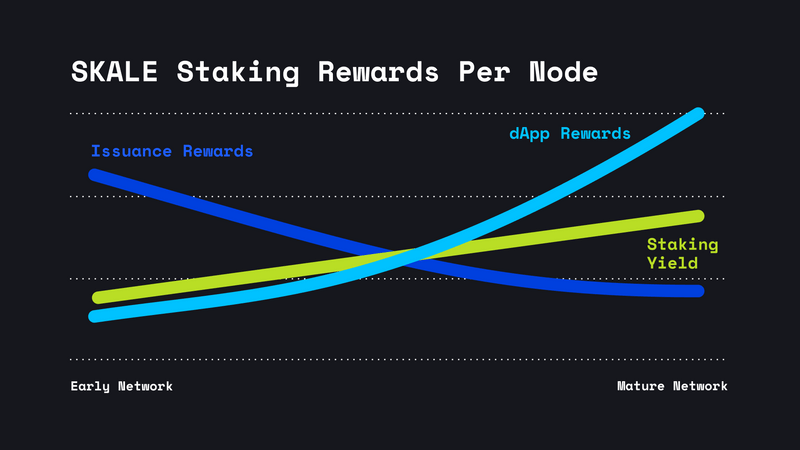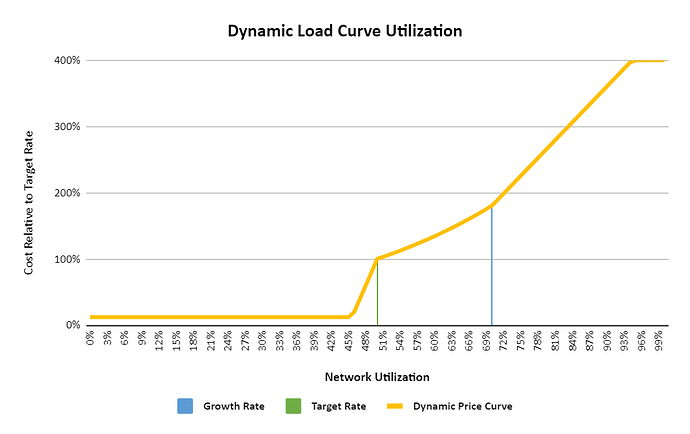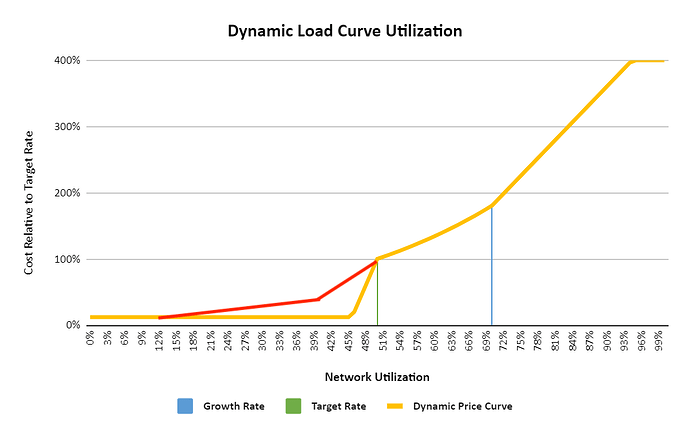SKALE is an open source, community driven project with a huge vision to bring the power of Ethereum to hundreds of millions if not billions of people. This is a big, audacious goal that relies very critically on the network’s ability to grow with sound and sustainable economics. This also means that the economic strategy must be strategic and tailored for each phase of network growth. SKALE’s core architecture lends itself to elasticity and flexibility in terms of both capacity and economics. That same powerful feature also brings about complexity which requires input and coordination from many different parties. Thankfully there are many actively involved constituents helping drive this strategy ranging from validators, dapp developers, core devs, delegators, and more. In order to bring about the next phase of economic transformation, we are pushing forward a high level proposal today and look forward to hearing your feedback, thoughts, and input with the goal of implementing chain pricing as soon as possible for the network. If this high level strategy is accepted we will then put forward a very specific proposal including smart contract language that will be voted on and if approved, pushed forward.
SKALE, like every major successful ecosystem within both the Web3 and Web2 landscapes, has prioritized growth and expansion over immediate revenue generation. This strategy is essential for maintaining competitiveness and fostering growth. Loss leader expansion over profit-centric tactics is a common practice across all tech fields and not exclusive to centralized entities. Fully decentralized networks like SKALE can leverage these methods as well, substituting centralized boards and companies with decentralized voting and governance to formulate strategies, then employing smart contracts for their implementation.
Traditional L1 blockchains operating with gas fees function similarly, where inflation subsidizes low gas fees in their network. Numerous high profile L1 networks boasting generating tiny amounts of fees owe their short-term sustainability to this inflationary offset, which allows them to adopt a growth-first/loss leader strategy. They however will eventually hit a crunch requiring them to increase fees or face the reality of running a perpetually subsidized economic model.
SKALE is uniquely positioned NOT to fall into this crunch. A key feature of SKALE Chains is that they don’t impose gas fees on end users. Instead, they are powered by Chain fees which compensate validators and stakers (delegators). Chain fees are supplemented by a descending inflation mechanism for validator rewards. To put it plainly, during the network’s first three years, a significant portion of fees designated for validator/delegator rewards were intended to come from inflation rather than fees. Each year, the inflation rate declines by approximately 10%, remaining static from year 6-12 before dropping again. To ensure the network’s success, fees need to play a crucial role in sustaining the network from years 3-6. By year 7, our aim is to have over 90% of rewards sourced from chain fees instead of inflation.
This inflation trajectory has been hard-coded into the SKL token smart contract from the network launch on October 1, 2020 and can only be modified through a decentralized vote.
Proposal and Stages:
As a reminder, the SKL token is utilized to add security to the network. The staking functionality has been in place since Oct 1, 2020 and ran for two straight months prior to the token being liquid via the Consensus Activate Proof of Use launch. In addition to staking, the SKL token can be used for both voting and chain payments. The early smart contract, design and flow of chain payment logic has been in place on Mainnet since network launch. Due to an overwhelming amount of input from the dapp and validator community there was a decision to push back the implementation with the goal of decreasing friction for dapp onboarding in the first phase of network growth. In addition SKALE decentralized governance was recently launched which now paves the way for the next evolution in SKALE Chain payments. As a part of this effort, the SKALE developer community has segmented the network economic evolution into three distinct phases which are detailed below. A governance proposal is currently being prepared by a cohort of decentralized constituents to pass Phase 2 of SKALE’s Economic Evolution.
Phase 1: Validating Network Viability and Stimulating Developer Demand
We are currently in the last days of Phase 1. In this phase, the bulk of chain fees were paid offchain and supplemented by grants, funneled directly into dapp growth programs, mirroring the AWS growth model. With the current market dynamics and competitive landscape where L1s and L2s provide “gas offset fee” grants to dapps, SKALE has adopted a similar approach in subsidizing chain fees. However, SKALE’s advantage lies in its unit economics for Chain offset fees, which are significantly more efficient than gas offset fees due to the manner in which validators are rewarded and how chain pricing operates compared to gas fee pricing.
This strategy has proven exceptionally fruitful for SKALE, with over 158 million transactions from over 1.4M unique active wallets across 20 active SKALE chains, resulting in more than 1.9B USD in saved gas fees in the last year.
With the network’s viability and value now confirmed, SKALE is poised to transition into the next phase of economic evolution and network growth.
Phase 2: Achieving Economic Viability and Sustainability
Following the commitment made by the core team and community developers not to modify any network economics without an on-chain vote, and with the recent approval of decentralized voting, SKALE is ready to advance into Phase 2.
The ultimate goal in this phase is for SKALE Chain pricing to reach a point of validator hardware profitability while setting a target load price of $1M USD equivalent in SKL tokens paid per year per chain with the network at a 70% load. The design of SKALE Chain price operates on a sliding scale where each additional chain costs more than the previous one when the number of nodes in the network is fixed. This system incentivizes validators and delegators to set up more nodes as the return increases, which will consistently keep the price per chain near the middle load price point.
Phase 2 is dedicated to establishing a financially sustainable foundation for validators, with chain pricing aimed at maintaining growth while ensuring validators can operate healthy businesses. The network utilization curve allows market dynamics to control the pricing of the chain throughout its evolution. Chain pricing will be calculated based upon the amount of chains being rented and the amount of active nodes in the network. Currently, chains will cost 8% of the Target Rate, which is ~$3,600 a month, until the network will hit 45% utilization. At the Target Rate, or 50% Network Utilization, the Network will lease chains at ~$46,000/month which will steadily climb until it hits the Growth Rate at 70% Network Utilization. At 70% Utilization, SKALE chains will cost ~$84,000 a month. As you can see in the chart, once the Network hits 70% Utilization, a steeper price curve is enacted to incentivize validators to run more nodes. This mechanic is used to maintain a healthy supply-demand balance of the chains.
Core aspects of Phase 2 chain pricing include compensating the total hardware costs of running base-level infrastructure. For instance, each SKALE Chain has 16 dedicated subnodes, estimated to cost between $250-$750 per month. Chain fees for the first six months will go entirely to validator operators, extendable with another successful vote.
The goal for SKALE Chain pricing in Phase 2 is to cover the hardware infrastructure costs for the network. Therefore, each chain will fund a smart contract paid in SKL tokens, with the quantity of SKL to be paid each month determined by an oracle input for the price of USDC at a rate of cost determined by the network utilization curve, which will fall in the range of $3,200 to $4,100 in SKL tokens per month and will be finalized by a SKALE DAO vote on Snapshot. This fee is being pushed forward as a temporary phase 2 rate which will help push forward economic sustainability while not inhibiting growth and will ultimately tee up the next phase which is about optimizing value capture with growth.
Moreover, these smart contract payments and token payouts to validators will occur on the SKALE Europa Chain, the primary liquidity hub of the SKALE Network. This will reduce gas fees for network operational costs and generate more economic activity on the Europa Hub.
Assuming the community is excited about this direction and sentiment is positive following this post, the technical OSS community supporting SKALE will publish a technical specification forum post. That will then be followed by a SnapShot proposal which will include code to be voted upon.
Phase 3: Accelerating Network Growth and Value Capture with Dynamic Pricing
Upon achieving a period of network stability and growth, and only with a successful vote, the network will transition into phase 3, focused on augmenting network revenue and value capture. The goal will be to move into this phase in the next 12-18 months.
In Phase 3, advanced dynamic pricing contracts using the network utilization curve will be extended below the 50% threshold, which will enable the network to capture additional value and further incentivize stakers and validator operators. The goal is to enhance the economic sustainability of the network and solidify SKALE’s position as a resilient, scalable and sustainable blockchain ecosystem.
Dynamic pricing in Phase 3 represents a significant evolution in SKALE’s economic model. This mechanism leverages advanced smart contracts and market dynamics to dynamically adjust chain prices based on supply and demand of SKALE chain rentals. This is where SKALE’s elasticity thrives and its limitless supply of SKALE chains, provides an infrastructure that actually allows for mass adoption within blockchain.
Dynamic pricing is not a new concept in the tech field, when you think of Uber surge pricing which incentives more drivers to drive, and gets more cars on the road for riders. However, this is novel to blockchain and is only possible through SKALE’s modular multichain model. This pricing mechanic empowers stakers and validator operators by offering enhanced rewards that align with the network’s growth and usage. As demand for SKALE chains increases, the dynamic pricing algorithm adjusts the SKALE chain price which encourages more Validators to operate nodes and more stakers to foster a healthy ecosystem of active participants. This influx of Validator nodes, allows for more SKALE chains to be rented which continues to drive flywheel until there is a market balance. This structure supports a healthy economic market and allows for developers to continue to grow. The demand will approach the Target Utilization Rate of 50%, and dynamic pricing of the SKALE chains will be enacted.
As the network continues to grow and capture additional value through dynamic pricing, it opens doors to new use cases and expands the SKALE ecosystem. The increased scalability and SKALE’s economic efficiency through pre-purchasing attracts developers and enterprises seeking a blockchain solution that can handle high transaction volumes at the lowest unit cost. This influx of dApps and businesses enriches the ecosystem, fostering innovation, collaboration, and the development of new revenue-generating models.
Throughout Phase 3, community engagement and decentralized governance remain essential pillars of the SKALE Network. The SKALE DAO governance enables stakeholders to actively participate in shaping the network’s economic policies, including the parameters and adjustments related to dynamic pricing. This democratic decision-making process ensures that the network evolves in a manner that aligns with the collective interests and values of the SKALE community.
Summary
The steps we are proposing aren’t just about growth and sustainability; they’re about strengthening our decentralized network and preparing SKALE for the long-term future that lies ahead.
The team is keenly aware that such a strategic transition requires the consensus of our community. As we’ve pledged, no changes will be implemented without the democratic decision of an on-chain vote. We genuinely encourage everyone to scrutinize this proposal, ask questions, and engage in the discussion.
In the coming weeks, further interviews with constituents, meetups, and developer/validator chats will take place with the goal of gathering final details so we can fully propose a vote through the SKALE DAO Snapshot. Please stay tuned for this important announcement.
SKALE is a community run, community owned, open source public good. We now have a cutting edge voting system in place. Let’s dig in and work together to make this transition successful and continue building a resilient, scalable, and sustainable network.
Thank you once again for being part of this exciting journey. We’re not just shaping the future of SKALE, but also influencing the future of decentralized technology at large as we push forward newer innovative decentralized business models.
Sincerely,
SKALE OSS Dev Contributors
—
About the SKALE OSS Dev Contributors
We are a committed group of developers that work on numerous parts of the SKALE project. We are a community of developers, core team developers, and other network constituents. Our goal is to push forward to initiatives of the SKALE project in a decentralized and community focused manner.


